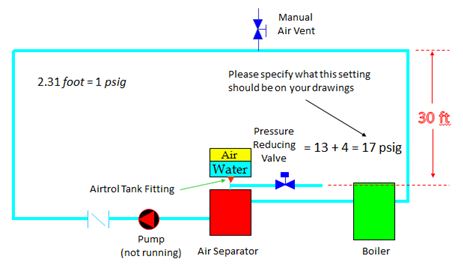|
Cold fill pressure is defined as the initial pressure required to lift water from the point of the gauge readout to the top of the system plus 4 PSIG for positive venting. This statement holds true for systems from chilled water to heating systems up to 220°F. From 220°F to 250°F, consult the Bell and Gossett Air Management training manual, available from R L Deppmann Company, serving Michigan and Ohio, or from your local B&G representative for other parts of the globe. We normally define “Cold” as the water temperature entering the hydronic system at the time it is filled. When verifying the proper cold fill pressure in an existing system, allow the water to circulate without heat until it is near room temperature. To calculate the “Fill Pressure”, take the elevation of the system above the gauge, divide by 2.31, and add 4 PSIG to it. The cold fill pressure in the example below is the setting of the pressure reducing valve (PRV). The “fill” pressure at the compression or expansion tank may be slightly more or less depending on the elevation of the tank, compared to the elevation of the PRV.
Let’s assume the compression tank, in the example above, is about 9 feet above the pressure reducing valve. Since 9 feet is about 3.9 PSIG, we would say the fill pressure in the tank is 13 PSIG. (17 PSIG minus 3.9 PSIG is about 13 PSIG) Next Monday Morning Minute will describe the difference between compression and expansion tank systems. |
|
Disclaimer: R. L. Deppmann and it’s affiliates can not be held liable for issues caused by use of the information on this page. While the information comes from many years of experience and can be a valuable tool, it may not take into account special circumstances in your system and we therefore can not take responsibility for actions that result from this information. Please feel free to contact us if you do have any questions.
See the rest of this series:


